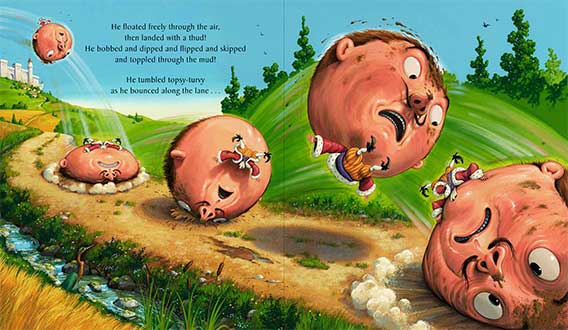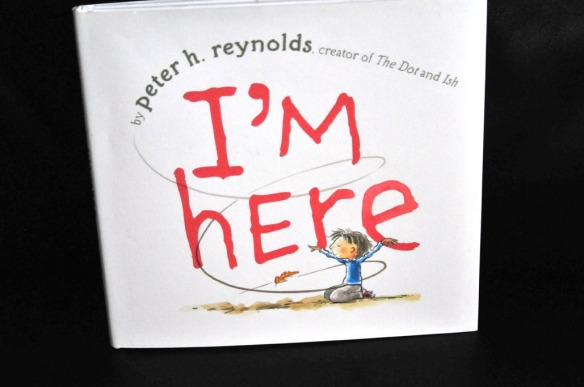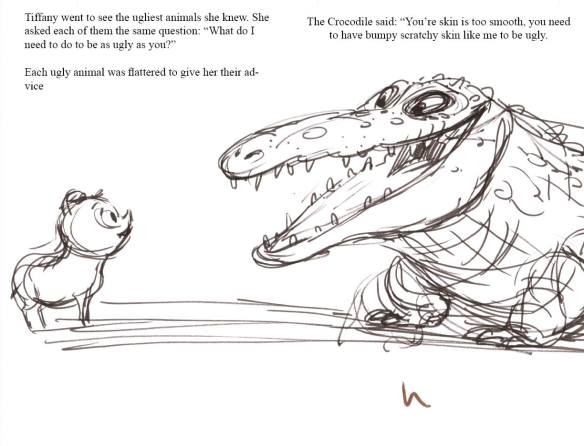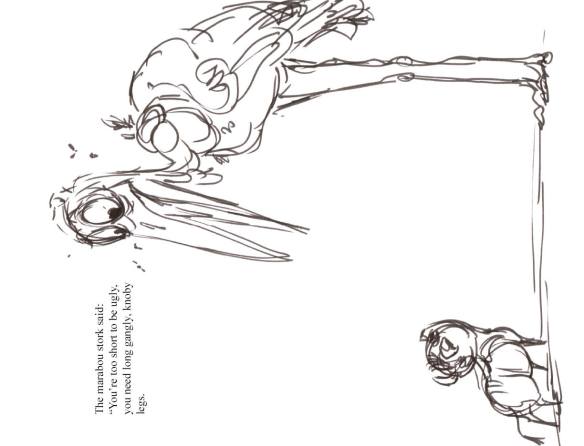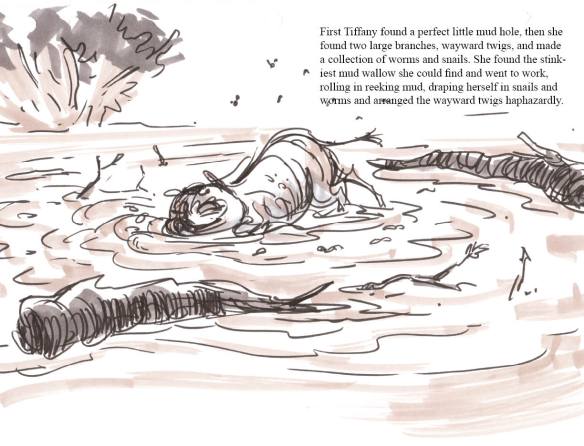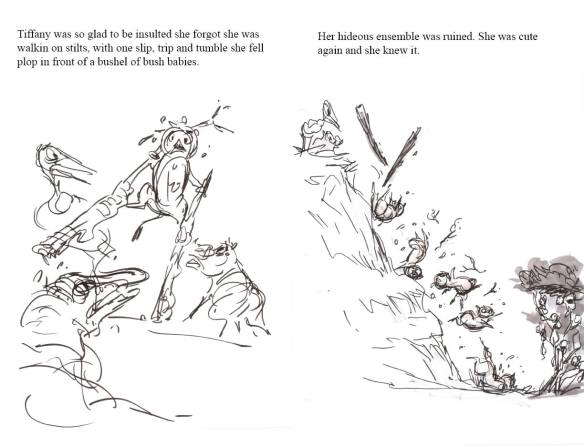Just finished inking this without messing it up. Now hopefully I don’t mess it up when I paint it. That’s what I love about using real mediums versus photoshop. There is no undo, the stakes are high do or die. I think it makes the artist more aware and present when you don’t have the automatic crutch of the undo button.
Tag Archives: children’s books
River Horse
I’ve always been bemused by the meaning of hippopatomus, which is river horse. Hippo meaning horse and patomus meaning river. I really don’t see the resemblance. If I were to rename the hippo in greek I’d name him chioropatomus which I think according to the internet (which we can never fully trust) would be greek for river pig (chioros). Either way I’ve always loved drawing hippos. This is a sample from a picture book I’m working on. More to come….
Six Questions for Chris Van Dusen

Chris Van Dusen is a force in children’s literature and art. He has contributed his talents to over a dozen books many of which are his own original stories. Among my favorites are his Mr. Magee series, Circus Ship and his latest, King Hugo’s Huge Ego. Chris and I have never met personally but both have admired one another’s work and after some correspondence we swapped books. I sent him Sid the Squid and he sent me Circus Ship.


Chris’ work and career is one for any artist to try and emulate including myself. So I asked Chris six questions about art, influences and story-telling. Here are his answers. I’m sure you’ll find them as inspiring and informative as I did.
Six Questions from author and artist Chris Van Dusen
David:
As an artist & author do you begin with a story or do you begin with a drawing?
Chris:
It can work both ways. Usually I start with a basic idea and
start mulling it over until a story forms in my mind. But sometimes
an image will pop into my head and I’ll do a quick sketch. Then I
think about the sketch, asking myself questions like, “who is that
guy?”, “how did he get there?” and “how will he get out of this
situation?”. That’s how my first book, “Down to the Sea with Mr.
Magee” developed.
David:
When you first write your stories do you build an outline and then develop your rhymes?
Chris:
After I have an idea for a story that I think might make a good
book, I create a story map to lay out the pages. This is usually just
a piece of paper with rectangles drawn on it that represent the
spreads of the book. Since most picture books are 32 or 40 pages
long, I briefly describe what will happen on each page, making sure
that the character(s) are introduced first, a conflict is presented
second and so on and so forth. I will sometimes change things around
to make sure the story is paced correctly. When I’m satisfied with
the story map, I then go ahead and write the story. Writing in rhyme
is a bit tricky though. It’s hard to write a story from beginning to
end because you may develop a rhyme that woks well at the end of the
story before you’ve even written the beginning. So often I’ll end up
with little scraps of paper that make up the entire story and then,
like a puzzle, I piece it all together. I also work really hard to
make sure my rhymes flow effortlessly. It’s all about beats and
rhythm- it’s really musical in a way. I’ve always said that if rhyme
is done well, you don’t even notice it, but if it’s off, it sticks
out like a sore thumb!
David:
In King Hugo’s Huge Ego you practically animate King Hugo bouncing up and down. Have you ever animated and have animated movies influenced your work?
Chris:
I’ve never done any animation, but I’ve been absolutely
fascinated by it ever since I was a little kid. I grew up watching
the Bugs Bunny/Road Runner Hour on Saturday mornings and I’m sure
that Warner Brothers has influenced my work. Hanna-Barbera, too. As a
result, most of my characters have a cartoon quality to them and my
colors are bright and clean, just like animation. It’s my dream to
have one of my books come to life through animation.
David:
Circus ship was inspired by actual events; are any of your other stories inspired by personal experiences or actual events?
Chris:
“The Circus Ship” is the only book of mine so far that was
directly inspired by an actual event. Some of my books have elements
from my childhood (like in “If I Built a Car”) but aside from SHIP,
they’re all made up. I’d like to explore another story from real
life, but so far I haven’t found the right person or event to write
about. I’m still searching.
David:
You have a great ability to exaggerate size and proportion to emphasize story points. The uncanny thing is your ability to make it seem natural. When Mr. Paine marches into town searching for his circus animals he’s literally taller than houses-but it doesn’t feel out of proportion. Can you explain how you approach exaggerating a character’s size to emphasize story and character?
Chris:
With each illustration, I sketch and sketch to find the best
scale, angle or perspective to depict the scene. It’s almost like I’m
a movie director composing a shot. Scale can help define a character.
In the illustration you mention from CIRCUS SHIP, Mr. Paine (the
villain) is indeed very big. But this is the part of the story where
he needed to appear intimidating and powerful. The people are scared
of him and his appearance on the island. Putting him in the
foreground allowed me to make him huge and the houses in the
background small by comparison. It’s how the scale would naturally
appear, but it has the subtle effect of a giant marching into town.
David:
On your website you state influences such as Dr. Suess and Robert McCloskey, are there any other artists who have influenced your work?
Chris:
There are so many artists who have influenced me and my work that
it would be impossible to name them all, but the list goes from N.C.
Wyeth to William Joyce. I’ve borrowed from the best!
Many artists are reluctant to share their methods and process. Chris on the other hand is charitable with his knowledge and compliments. In this digtal era were any mistake can be erased by hitting undo on your computer Chris uses actual media typically using gouache his medium of choice. At the end of the day Chris proves to me that it’s not so much his technique but the ideas and story that drive his artwork and books making them both timeless and memorable. Chris’ stories belong in every artist’s studio and every family’s library.
Not a Dinosaur a Dimetrodon
Book Review: I’m Here, by Peter Reynolds
Peter Reynolds has been an inspiring figure in children’s literature for me. Long before I decided to throw my lot into quagmire of children’s lit I admired the art and stories of Peter Reynolds. His books are uncommonly positive and uplifting. One of my favorite books penned and illustrated by Peter is “Ish,” which encourages the artist in every child and the child in every adult. In Peter’s latest book “I’m Here,” Peter skillfully and simply paints the world as an autistic boy experiences it. A playful playground becomes a confusing cacophony of noise forcing the overwhelmed boy to isolate himself. Even in the boy’s isolation he is “here” and ultimately finds friendship through a paper plane and a friendly girl. Like a good writer and artist Peter has something to say and not only jokes to tell. “I’m Here” paints an empathetic and beautiful picture of what it is like to “be here” and be autistic.
Peter has a fantastic blog: http://stellarcafe.blogspot.com/
Story Marathon: Once and Future Dinosaur
Satellite School (story marathon cont)
I have the worst parents in the world!- story marathon continued
Horribly Adorable
This is a dummy I worked up last year for a picture book called Horribly Adorable. It was inspired by real live warthogs. A few years ago I went to Africa and I saw my first warthog. They may be ugly but I think they’re pretty darn cute. I still think the idea has merit, however like many ideas this one didn’t quite take off.
Parakeet and primordial ooze
Making children’s books is a lot like story work on animated movies. There are a lot of ideas that just don’t make it. Sometimes the ideas are great, super funny but they might not fit in the jugsaw puzzle which is story. They are the bits and pieces left on the cutting room floor. I always hold on to these ideas, you never know if you’ll have a EUREKA moment that will further propel the idea. Sometimes I feel like these nuggets or discarded stories are floating in a primordial ooze just waiting to evolve. Some are dead ends and others just need that spark to help them evolve out of the ooze and into a functioning story.
I’m always hesitant to share images from unpublished or unrepresented ideas but here are a few images I worked up a few months ago for a picture book based on a parakeet and a boy. The images were fun to do and were done in sumi ink and watercolor.




